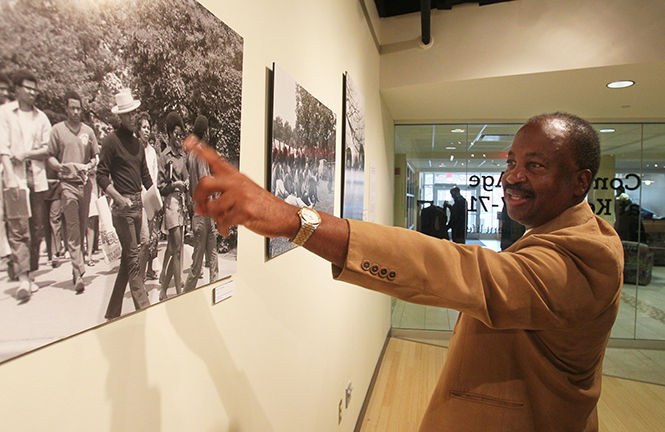Lafayette Tolliver: Rehashing and recording history
February 10, 2015
Imagine a time when the former Daily Kent Stater headlines read more like time bombs: “Time for revolution,” “Kent stunned by walkout” and “Turning point for blacks.”
Looking back at the campus newspapers from the ‘60s, it’s without a doubt that Kent State has seen more than one struggle and turning point in its time as an institution.
Enter Lafayette Tolliver.
A photojournalism student and black movement activist who attended Kent State from 1967-71, Tolliver witnessed and captured these events as they occurred on campus, as well as documented black life at Kent State.
Through his photos and columns, Tolliver, only one of the two African-American students in the School of Journalism and Mass Communication (JMC) at the time, was able to document black student life, promote change and ultimately leave his mark on the university.
“During the ‘60s, Kent State was seen many times as a boiling pot for a lot of student activism,” Tolliver said. “Nationwide, people would come to Kent because we were very receptive to those types of ideas, and they found a very welcoming climate at Kent State.”
As the anti-war protests of the late 60s began to lead up to the May 4 shooting, Tolliver said the black movement, simultaneously, was a time of civil unrest for African-American students at Kent State, who were fighting their own battle for equal treatment, equal opportunities and more consideration by the administration on campus.
“I would say it was more of a turning point for the times,” Tolliver said. “Kent State was at the cutting edge of really being an activist college that really makes changes as far as the social fabric.”
During Tolliver’s four years at Kent State, he was a part of Black United Students (BUS), a student organization founded on May 21, 1968 by his older brother, William Tolliver, and Dwayne White.
BUS was formed as a response to the inequality black students faced on campus and served as a place where African-American students could come together to celebrate their heritage, history and culture while furthering their involvement on campus.
Tolliver and other activists participated in walkouts and sit-ins and met with administration, like former Kent State President Robert White, almost regularly to discuss their needs as a black community in Kent.
“I thought he (White) was a very acclimatable, nice person. He wasn’t so-called ‘ugly’ or ‘bitter’ or ‘rancorous,’” Tolliver said. “He was quite open and receptive, and I think he was a very important ally in what we (BUS) were doing.”
In addition to attending advocacy and cultural BUS events, Tolliver also devoted much of his college career to documenting what he refers to as “visual footprints” in time.
“I always thought as being a photojournalism major, why not use what I was being taught or trained in the actual practice of it,” Tolliver said.
Tolliver worked as a photographer, columnist and reporter for both the Daily Kent Stater and the Chestnut Burr.
He said that majoring in photojournalism made it possible to blend together his passion for the written word and photography.
“Whenever you saw me at Kent State, you always saw me with my camera. We were one in the same,” Tolliver said. “That’s why I had so much access…I was always taking pictures, and after a period of time, it’s almost to the point that you’re seen as the unofficial person who documents history.”
Tolliver also wrote columns and articles for the Daily Kent Stater, which ranged from social issues within the black community to his reaction about on-campus events.
“When I was attending Kent State, we had the shooting of Dr. Martin Luther King Jr.,” Tolliver said. “That was a turning point for me as far as using the so-called ‘power of the pen.’”
“He (Tolliver) was a trailblazer,” said Eugene Shelton, a JMC associate professor who attended some of his college career with Tolliver. “I simply followed him. He was ahead of me in so many ways, that is where the respect (for him) is based.”
Almost 50 years later, Tolliver’s works were inducted into the University Special Archives at Kent State with the help of university archivist Lae’l Hughes-Watkins.
Tolliver’s works were the first collection of its kind to document black student life at such magnitude, Hughes-Watkins said, and collections like these help us understand the time period better by being aware of the past so as not to repeat it, especially the negatives.
“I feel his collection gives insight to the life of the black students at that time, meaning that there wasn’t just one thing they were interested in,” Hughes-Watkins said. “Everybody wasn’t just militants; there were students who were just coming here trying to go to class everyday or that they were involved in going to different activities on campus.”
Contact Jenna Kuczkowisk at [email protected].












